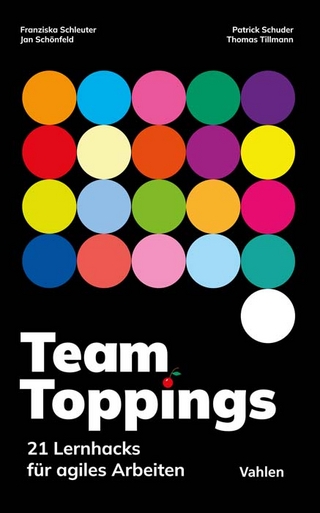
The Complete Software Project Manager
John Wiley & Sons Inc (Verlag)
978-1-119-16183-7 (ISBN)
Your answer to the software project management gap The Complete Software Project Manager: From Planning to Launch and Beyond addresses an interesting problem experienced by today's project managers: they are often leading software projects, but have no background in technology. To close this gap in experience and help you improve your software project management skills, this essential text covers key topics, including: how to understand software development and why it is so difficult, how to plan a project, choose technology platforms, and develop project specifications, how to staff a project, how to develop a budget, test software development progress, and troubleshoot problems, and what to do when it all goes wrong. Real-life examples, hints, and management tools help you apply these new ideas, and lists of red flags, danger signals, and things to avoid at all costs assist in keeping your project on track.
Companies have, due to the nature of the competitive environment, been somewhat forced to adopt new technologies. Oftentimes, the professionals leading the development of these technologies do not have any experience in the tech field—and this can cause problems. To improve efficiency and effectiveness, this groundbreaking book offers guidance to professionals who need a crash course in software project management.
Review the basics of software project management, and dig into the more complicated topics that guide you in developing an effective management approach
Avoid common pitfalls by perusing red flags, danger signals, and things to avoid at all costs
Leverage practical roadmaps, charts, and step-by-step processes
Explore real-world examples to see effective software project management in action
The Complete Software Project Manager: From Planning to Launch and Beyond is a fundamental resource for professionals who are leading software projects but do not have a background in technology.
ANNA P. MURRAY, a nationally recognized technology consultant, speaker, and blogger, is president of emedia, a provider of software development, high-level technology consulting, and project and program management. She is a double winner of the Stevie Award for Women in Business, a recipient of a Mobile Marketing Association award for mobile app development, and Folio's Top Women in Media award.
FOREWORD xvii
ACKNOWLEDGMENTS xix
ABOUT THE AUTHOR xxi
INTRODUCTION xxiii
CHAPTER 1 Software Development Explained: Creativity Meets Complexity 1
A Definition of Software Development 1
Why Is Software Development So Difficult? Hint: It’s Not Like Building a House 1
The Simple, the Complicated, and the Complex 2
Metaphor #1: Piles of Snow 3
Metaphor #2: The Ikea Desk 4
Metaphor #3: Heart Surgery 5
Using the Three Metaphors in Project Management 6
CHAPTER 2 Agile, Waterfall, and the Key to Modern Project Management 7
Agile and Waterfall 7
Waterfall 7
Waterfall’s Problems 8
The Requirements Requirement 9
Inflexibility 9
Loss of Opportunity and Time to Market 9
Customer Dissatisfaction 10
Agile 10
Lack of Up-Front Planning 12
Lack of Up-Front Costs 12
Stakeholder Involvement 13
Extensive Training 13
Where Agile Works Best 14
The Need for Up-Front Requirements in Many Projects 14
The Real World 15
Agile Enough 15
The Software Development Life Cycle 15
CHAPTER 3 Project Approaches; Off-the-Shelf and Custom Development; One Comprehensive Tool and Specialized Tools; Phased Launches and Pilots 17
The Custom vs. Off-the-Shelf Approach 18
History 18
The Benefit of Off-the-Shelf 19
Off-the-Shelf Examples 19
Thinking You’re Editing When You’re Actually Creating 20
Common Challenges with Off-the-Shelf Software 20
Business Compromise 21
Discovering You Made the Wrong Choice with Packaged Software 21
Breaking the Upgrade Path 21
Locked into a Partnership and the Product Roadmap 22
Expense of Off-the-Shelf 22
Where Packaged Software Works Well 23
Frameworks and the Blurring Worlds of Custom and Packaged Software 23
Integrations vs. One Tool for the Job 24
To Phase or Not to Phase 25
Bigger Is Not Always Better 26
The Pilot Approach 26
Why Not Pilot? 27
CHAPTER 4 Teams and Team Roles and Responsibilities Defined 29
Teams and the Roles on Teams 29
Project Leadership 30
The Key Business Stakeholder 31
The Project Sponsor 31
The Program Manager 32
Project Manager 32
Multiple Project Managers 33
Confusion About the Project Manager Role; It’s More Limited than You Think 34
Project Team 34
The Business Analyst 35
User Experience 35
Designer 35
The Programmers 35
Architect 36
Systems Administrator 36
Team Member Choice and Blending Roles 37
Getting All the Roles Covered 37
Real-World Examples for Role-Blending 38
Project Sponsor as Program Manager 38
Program Manager as Business Analyst 39
Front-End Programmer as User Experience 39
Design, UX, and Business Analysis 40
Back-End Programmer as Architect 40
SysAdmin as Architect 40
Professionals and Personalities 40
Programmers 40
Project Managers 41
Business Analysts and User Experience People 42
Architects and Systems Administrators 42
Insource or Outsource: Whether to Staff Roles with Internal People or Get Outside Help 43
The Myth that Insourcing Programming Is Better 43
Inexperience with Projects 44
How Knowledge Goes Stale 44
Outsourced Teams 44
When to Use Internal or External Teams 45
Roles Easiest to Outsource 46
Roles “in the Middle” 46
Roles that Are Usually Internal 47
Vendors and Hiring External Resources 47
Some Tech-Types to Avoid: Dot Communists and Shamans 47
The Shamans 48
Boundaries, Responsibilities, and Driving in Your Lane 49
Techies Who Don’t Drive in Their Lane 50
Business Stakeholders Who Shirk Responsibilities 50
Business Stakeholders, Step Up! 51
Have a Trusted Technology Partner 52
How Best (and Worst) to Work with Your Technology Partner 52
Too Many Cooks 53
CHAPTER 5 Project Research and Technology Choice; Conflicts at the Start of Projects; Four Additional Project Delays; Initial Pitfalls 55
Choice of Technology, a Definition 56
The Project’s Research Phase 56
Current State 56
Integrations and Current State 57
Data and Current State 57
Business Needs 58
Possible Technology Solutions 58
Demos 59
Comparison Grids 59
Talk to Other People, a Journalistic Exercise 60
How Do You Know When Your Research Is Done? 61
Research Reality Check 62
You Can’t Run the Control 62
Religious Wars 63
Passion over Reason 64
Business Stakeholders and Controlling Ego 64
How to Stop a Technology Religious War 65
Not So Easy 65
Preventing a Technology Religious War 65
Being Right 66
Stopping a War in Its Tracks 66
Détente and Finally Ending a Technology Religious War 67
Clarity 67
The Role of the CIO 68
Two Most Important Factors in Core Technology Decisions 69
Budget Constraints 69
The Team 69
Choosing Technology and What NOT to Consider: The Future 70
Other Conflicts that Delay the Start of Projects 71
Business Strategy and Organizational Authority 71
Design 73
Blue Sky 73
Overanalysis 74
The Project Charter, a Key Document 74
CHAPTER 6 Final Discovery; Project Definition, Scope, and Documentation 77
Budgeting and Ongoing Discovery; Discovery Work Is Real Work 78
Budgeting Final Discovery 78
What Discovery Costs 79
What Comes Out of Final Discovery: A Plan 79
Getting to a Plan 80
The Murk 80
Getting Out of the Murk 81
The Plan for the Plan—Company A 82
Hosting 82
Content Entry 82
Search 82
Content Pages and Features 83
Integrations 83
Back-end System 83
Data Migration 84
How Anyone Can Make a Plan for the Plan 84
Different Approaches to Elicit the Plan for the Plan 85
Exception to the Murk 86
Breakout Sessions 87
The Weeds Are Where the Flowers Grow 87
Not All Questions Will Be Answered 88
Agile, Waterfall, and Project Documentation 89
The Scope Document 90
Project Summary 90
Project Deliverables 90
Out of Scope 90
Constraints 91
Assumptions 91
Risks 91
Timeline 92
Budget, Scope, Timelining, and Horse-Trading 93
Metrics 93
What About “the List”? 94
Defining and Visualizing and Project Scope 94
What Usually Happens 95
The Chicken and the Egg 95
Common Questions 97
Where Does Design Fit In? 97
Working with Marketing Stakeholders 98
How You Know You’re On the Wrong Track 98
A Word About Ongoing Discovery 99
CHAPTER 7 Budgeting: The Budgeting Methods; Comparative, Bottom-Up, Top-Down, and Blends; Accurate Estimating 101
An Unpleasant Picture 102
What Goes on Behind the Scenes; a Scene 102
Budgeting Type 1: Comparative Budgeting 103
Gotchas with Comparative Budgeting 104
Budgeting Type 2: Bottom-Up Budgeting 104
The Rub in Bottom-Up Budgeting 105
Budgeting Type 3: Top-Down and Blends 105
Why RFPs Don’t Work 106
Accurate Estimating and Comparison Budgeting 107
Effective Estimating in Top-Down and Bottom-Up Budgeting 108
Establish a Base Budget for Programming, Ongoing Discovery, Unit Testing, Debugging, and Project Management 108
Percentages of Each 108
Programming Hours—Raw and Final 109
The Math Part 109
Additional Items to Consider 111
Budgeting and Conflicts 112
CHAPTER 8 Project Risks: The Five Most Common Project Hazards and What to Do About Them; Budgeting and Risk 115
Five Always-Risky Activities 116
Integration 116
Data Migration 117
Customization 118
Unproven Technology/Unproven Team 119
Too-Large Project 119
Want Versus Need 119
Want Versus Need: Programmers 120
Want Versus Need: Business Stakeholders 120
Optimism Is Not Your Friend in Software Development 120
Beware the Panacea Claim 121
Facing Risks 121
A Few Words About Fault 121
Identifying Risks Up Front 122
Embrace the Snow 122
Talking to Your Boss 123
Hidden Infections 124
Bad Technology Team; Wrong Technology Choice 124
Too Many Opinions and Lack of Leadership 124
The Contingency Factor 125
The Cost of Consequences 125
Contingency Percentage Factors 126
In the Real World 126
The Good News 127
A Common Question 127
Long-Term Working Relationships and Contingency 127
CHAPTER 9 Communication; Project Communication Strategy; from Project Kickoff to Daily Meetings 129
Project Kickoff 130
Project Kickoff Cast 130
Project Leadership 130
Company Leadership 131
Who Gives the Kickoff? 131
Kickoff Presentation 131
High-Level Project Definition 132
Business Case and Metrics 132
Project Approach 133
Team Members and Roles 133
Project Scope 134
Out-of-Scope 134
Timeline 134
Budget 135
Risks, Cautions, and Disclaimers 136
Monthly Steering Committee 137
Monthly Steering Committee Attendees 137
Monthly Steering Committee Agenda 137
Weekly Project Management Meeting 139
Weekly Project Management Attendees 139
Weekly Project Management Agenda 139
Daily Standup Meeting 140
Well-Run Meetings 140
Insist on Attention 140
Timeliness 140
Getting “into the Weeds” 141
Needs to Be Kicked Upstairs 141
Poor Quality Sound—Speakerphones and Cell Phones 142
Too Much Talk 142
Agenda and Notes 143
CHAPTER 10 The Project Execution Phase: Diagnosing Project Health; Scope Compromises 145
What Should Be Going on Behind the Scenes 145
The Best Thing You Can Ever Hear: “Wait. What Was It Supposed to Do?” 146
Neutral Corners 147
What If Things Aren’t Quiet? 147
Making Decisions 148
How to Listen to the Programmers 149
The Programmer’s Prejudice 149
SneakerNet and the Fred Operating System 150
SneakerNet Integrations 150
The Fred Operating System 151
The Hidden Benefits 151
Demos and Iterative Deliverables 151
Why Iterative Deliverables Are Important 151
Why Iterative Deliverables Are Hard 152
What You Can Do to Achieve Iterative Deliverables Even if It’s Hard 153
Demos 154
Scope Creep 154
Dealing with Scope Creep; Early Is Better 155
Scope Creep and Budgeting 155
Scope Creep and Governance 155
Types of Scope Creep 156
Scope Creep and the Team 157
CHAPTER 11 First Deliverables: Testing, QA, and Project Health Continued 159
The Project’s First Third 159
The Second Third 159
A First Real Look at the Software 160
The Trough of FUD 161
Distinguishing a Good Mess from a Bad Mess 163
An Important Checkpoint 163
Getting to Stability 164
First Testing and the Happy Path 164
Quality Assurance 165
Bug Reporting 165
Regression Testing 166
Bugs: Too Many, Too Few 166
Testing: The Right Amount for the Job 166
Too Much Testing? 167
Bug Cleanup Period 167
Timeline So Far 168
CHAPTER 12 Problems: Identifying and Troubleshooting the Three Most Serious Project Problems; Criteria for Cancellation 169
A Rule About Problems 169
Additional Resources 170
Fault—A Review 172
Common Late-Stage Problems 172
Business User Revolt: “We Talked About It in a Meeting Once” 172
Managing Business User Revolt 173
What If No or Little Documentation Exists? 174
Risk Chickens Come Home to Roost 175
Managing the Risk Chickens 176
When Programmers Ask for More Time 178
Lurking Infections 178
Bad Technology Team 179
How to Manage a Bad Technology Team 179
Wrong Technology Choice 180
Managing a Wrong Technology Choice 180
The Sunk-Cost Bias 181
Lack of Leadership 181
Managing Lack of Leadership 181
CHAPTER 13 Launch and Post-Launch: UAT, Security Testing, Performance Testing, Go Live, Rollback Criteria, and Support Mode 183
User Acceptance Testing: What It Is and When It Happens 183
Controlling UAT and “We Talked About It in a Meeting Once,” Part Deux 185
Classifying UAT Feedback 185
Bugs 186
Not Working as Expected—The Trickiest Category 186
Request for Improvement 187
Feature Request 188
Conflict Resolution and Final Launch List 188
Load Testing 189
Performance Testing 189
Security Testing 189
Sign-Off 194
Questions to Ask Regarding Launch Readiness 195
Not Knowing Is Not Acceptable 195
Criteria for Rollback 196
Singing the Post-Launch Blues 196
Was It All a Big Mistake? 198
Metrics 198
Ongoing Development 198
Surviving the Next One 199
APPENDIX 201
GLOSSARY 215
INDEX 223
| Erscheint lt. Verlag | 26.2.2016 |
|---|---|
| Reihe/Serie | Wiley CIO |
| Verlagsort | New York |
| Sprache | englisch |
| Maße | 160 x 239 mm |
| Gewicht | 435 g |
| Themenwelt | Mathematik / Informatik ► Informatik |
| Wirtschaft ► Betriebswirtschaft / Management ► Projektmanagement | |
| ISBN-10 | 1-119-16183-5 / 1119161835 |
| ISBN-13 | 978-1-119-16183-7 / 9781119161837 |
| Zustand | Neuware |
| Informationen gemäß Produktsicherheitsverordnung (GPSR) | |
| Haben Sie eine Frage zum Produkt? |
aus dem Bereich


